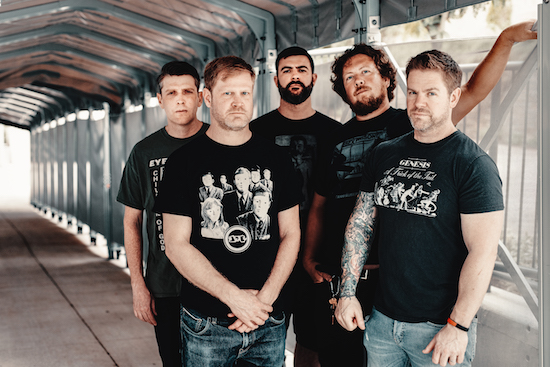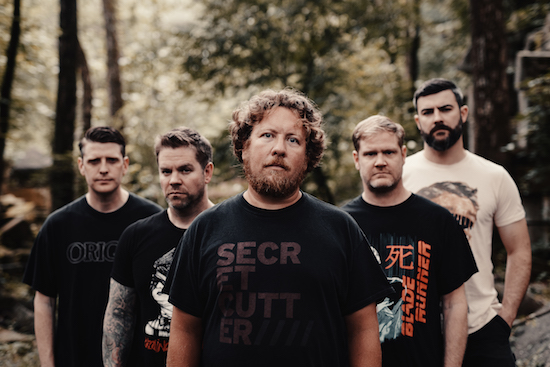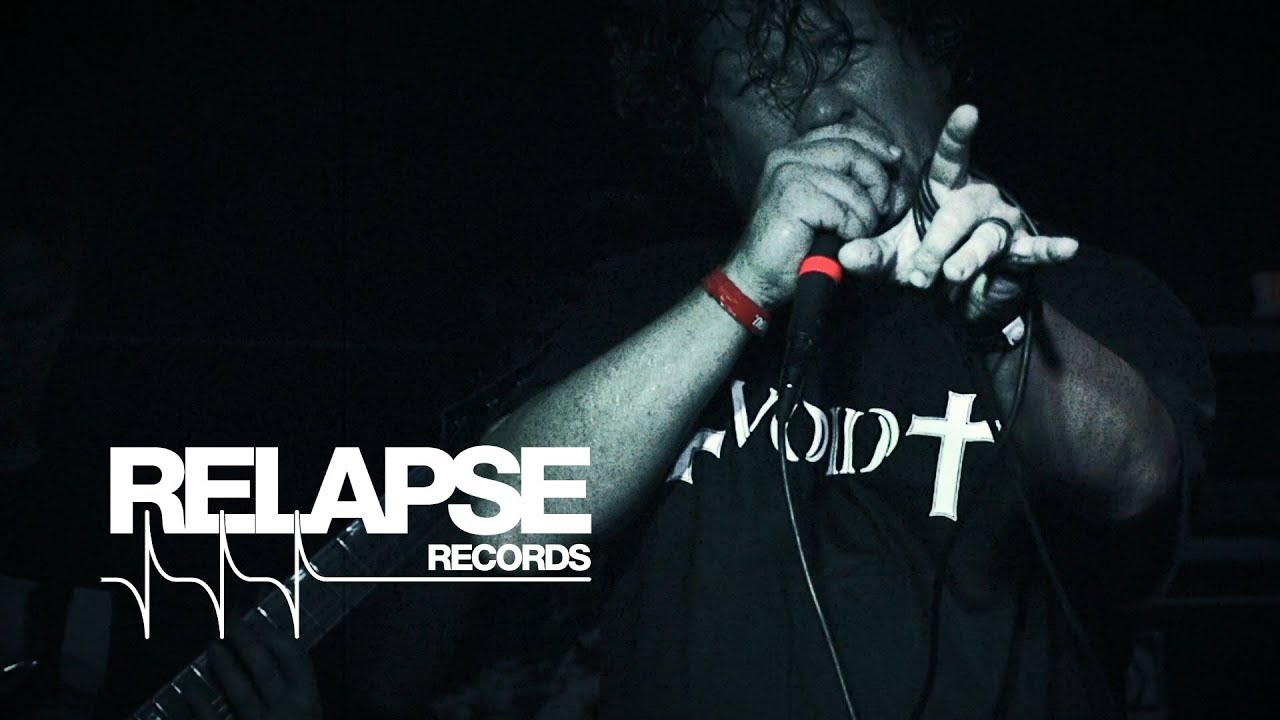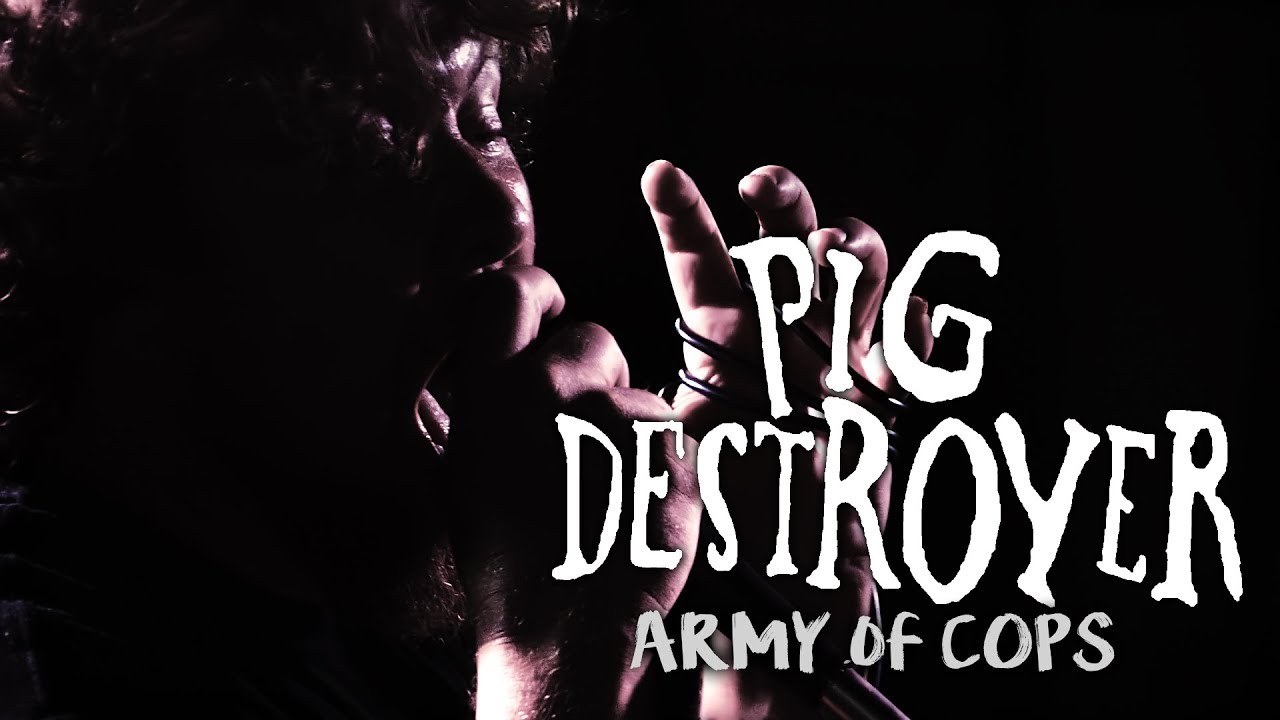All Pig Destroyer portraits by Joey Wharton
If speed kills, grindcore incinerates. In the eighties, when American thrash metal was attacking the neoliberalism of Ronald Reagan and reflecting the fears of a new era of pre-emptive nuclear attack, a mutation occurred. A new kind of drumming began to creep in to thrash metal ‒ ‘blasting’ – and with it grindcore: a kind of music so chaotic and so utterly furious that it was dumbfounding, if not outright hilarious.
There is an opposition at the heart of grindcore. It is simultaneously some of the most politically engaged music in metal, staring the horrors of the world hard in the face, but is composed of the genre’s most inhuman sounds. Its sonic atrocities are underpinned by the blast beat that gives it propulsion, the bass tones that impart its titular grind, and the vocal ravages that destroy language itself. And it’s very, very, very fast.
In the UK, Napalm Death were its pioneers, gleefully sending up Margaret Thatcher’s vision of unfettered capitalism and the social repression that accompanied it. In the US, it was more diffuse, but the band Terrorizer (released like Napalm Death, by Earache Records), were at its forefront.
Terrorizer was a supergroup side-band of sorts, comprising members of death metallers Morbid Angel, who temporarily dispensed with their exploration of ancient and satanic evil for a more socially engaged evisceration of The Evil That Men Do. The mental and societal damage done by the threat of nuclear war was as catastrophic as the event promised to be itself.
On World Downfall, released in 1989, the band posits a post-human landscape unburdened of people; the listener is buffeted by the album’s globalist angst and snarling social commentary. The chorus of its lead-off track, ‘After World Obliteration’, reads like post-apocalyptic haiku: “Suffering/ Deep in our minds/ After World/ Obliteration”.
Grindcore dwelt on the fringes of culture during the latter part of the Cold War, but in 2018, with Pig Destroyer’s Head Cage, it has moved to occupy the centre: a ferocious sonic blender of the heaviest ingredients – it takes down the security state (‘Army Of Cops’), skewers those who dodge having the courage of their convictions (‘Circle River’), and decries how quick we are to turn on each other when we do express our beliefs (‘Trap Door Man’). The album points to a personal and social malaise that is endemic in the second decade of the twenty-first century. It is the sound of a mass psychic breakdown enabled by new tech tools of self-harm. Our heads are getting fucked up, and Pig Destroyer are gleefully applying more pressure.
Privileging emotional torment, Pig Destroyer’s music violently switches in modes like a mind with a personality disorder. But it is only recently that the New Dark Age (to borrow technology writer James Bridle’s phrase) of online culture has optimised the conditions to damage our mental health in the way once simulated, but now truly performed, on their albums. The head cage as a medieval instrument of torture has undergone its digital transition. America, Russia and everyone else have moved their weapons of warfare online, making us citizens unwitting pawns and our minds collateral damage. Grindcore is the sound of ongoing global collapse in the modern era and Pig Destroyer are its rabid gravedancers.
Grindcore is like a ramshackle fairground ride that throws its audience around with reckless abandon: at its best it is ‘fun’ in a hysterical sense, but at moments it is genuinely destabilising. Of all the rigidly categorised subgenres in metal, it is the most open to having disparate musical elements poured into it: warp-speed hardcore punk jostles with slow-motion doom, highly technical fretwork is thrown into chaos by messy dissonance.
Whether it was Craig Charles playfully interviewing Napalm Death on What’s That Noise in 1989, or Radio DJ Chris Evans delightedly inviting them to perform ultra-short blasts of ‘The Kill’ and ‘Dead’ on TFI Friday a decade later, or former Labour party leader Ed Miliband taking a barking tutorial from Barney Greenaway on Radio 2 for all the social media lolz in 2017, Napalm Death’s position as the godfathers of the most extreme of the extreme has given them an unusual commercial accessibility. And through them, grindcore has been in the public consciousness unlike any other metal variant, for decades.
But it’s not just Napalm Death. In its totality, grindcore can be very funny. Watch Seth Putnam roll around onstage in his pumps, performing backward rolls, exposing his belly and confronting the audience in a largely empty field as Anal Cunt (yep) play Maryland in 1993, or Discordance Axis lay waste to CBGBs and its seemingly paralysed audience in 2000, or Agoraphobic Nosebleed not even bother to try to reproduce their programmed drums live in 2015. This is not to belittle the talent on display (‘talent’ in Anal Cunt’s case), but grindcore is much more adept at embracing its inner ridiculousness than any other genre in metal (a form of music in which ridiculousness is baked in). It’s a tank driven by clowns. But it has a serious underside. It’s funny – until you get crushed by caterpillar tracks.

As the millennium turned, Pig Destroyer did something different with grindcore. Their album Prowler In The Yard was released in July 2001, in a relative lull in macro-global tension between the end of the Cold War and just before 9/11. They shrank the focus of their music into a claustrophobic new head space. Singer J.R. Hayes created twisted, quasi-poetic portraits of lust and obsession, often centring on a female object of desire, love and pain. In this world, women are terrifying, but more often they are terrified: subjected to gross violence and degradation.
In the terrible world of Pig Destroyer’s earlier albums, love is an affliction – sadism and masochism bound together like two coiled snakes. The protagonist of ‘Starbelly’ is “cutting myself on scraps of you”, the object of ‘Towering Flesh’ has “lips wet with venom”, and the cadaver of ‘Rotten Yellow’ is “a masterpiece torn to pieces”. These songs tell us that individuals can go too far in obsession, past the point of being able to rend oneself from the object of desire, despite the fact ‒ because of the fact ‒ it is losing its allure. The bond of no longer loving someone cannot be broken.
In this early work, Hayes draws very frequently on imagery of flowers – beautiful and fragile but also too pungent, even sickly: on ‘Rotten Yellow’ he screams that “Her skin/ Is yellow/ Like the wildflowers/ In July”; when touched on the arm by the woman in ‘Towering Flesh’ he writes that “Flowers grow there/ Poisonous and obscene”, and on ‘Piss Angel’ (the flaying closer of Prowler In The Yard), the protagonist is caressing the headless torso of his victim in a “personal nightfall” shaded by “an eclipse of the sunflowers”.
On their 37-minute long ‘Natasha’ – which shows another face to Pig Destroyer, one comfortable with mass, slowness and drone – the titular character confesses an infidelity to the narrator, before he inevitably murders her, explaining that he “put her in the ground like a flower”. Male desire is destruction. This obsessive love cannot be resuscitated when it is dead. Hayes is well-read enough to probably know how it is put in Anna Karenina: “He looked at her as a man looks at a faded flower he has plucked, in which he can barely recognise the beauty that made him pluck and destroy it.”
After a section of shimmering, profound guitars that bears more in common with the title theme from A Clockwork Orange than anything written by Napalm Death, ‘Natasha’ disintegrates into wretched torture-doom. It is as if the riffs themselves are dragging Hayes’s character to his demise, wrenching abysmal shrieks out of him. He is being consumed by Natasha’s corpse itself, which has transfigured into some sort of underground tunnel: “I scream as I see her lovely mouth five times the size of me”.
This horrific, unworldly conclusion is a conscious callback to the epilogue of the short story ‘Jennifer’ that bookends Prowler In The Yard. In it, our heroine Jennifer inserts her hand, then arm, then whole body, into the vagina of a girl she had wrestled to the ground by a theme-park snow cone stand. As the weird, unnerving, synthesized voice of the narrator recounts how she disappears into the girl’s womb, Pig Destroyer’s message is that the object of any desire will eventually absorb and then destroy us.
On Head Cage, Hayes draws a line under all the years of this perversity. On ‘The Last Song’ he suggests that “this is the last song/ i’ll ever write/ about your pale skin/ in white light/ how your eyes/ are two deep mines/ full of diamonds”. He manages to end the song saying, “I only want the best for you”, which is good progress from the conclusion of ‘Starbelly’ from 17 years previously: “I hope I’m dead by the time you read this. I love you.”
Pig Destroyer promise unbelievable speed or morose dirges (and always plenty of head-spinning flair and groove), but Head Cage sees them explore mid-paced songwriting like never before. It is not straightforward though. Guitarist and band mastermind Scott Hull wrangles and contorts his riffs, putting his rhythm section – drummer Adam Jarvis and his cousin, bassist John Jarvis (who Hull brilliantly refers to collectively as “the Jarvi”) – through numerous gear-shifts and mood changes.
The hulking ‘Concrete Beast’ evinces this muscle-flexing: powering up, turning on its axis, reversing, pulling forward again. Hull himself is a physical powerhouse, built like a college football player. When I saw the band on the tour of 2012’s Book Burner, Hull kept a weed pipe on a chain around his neck like a gym instructor’s whistle.
‘Concrete Beast’ features Agoraphobic Nosebleed’s Katherine Katz on vocals, a guest appearance which follows up from her lead vocals on the scathing ‘Eve’ from Book Burner, a minute-and-a-quarter of distilled brilliance: from the triumphant opening chords, to the totally manic blasting and a trademark Pig Destroyer chug-out of palm-muted triplets to close. Katz is truly vicious on the mic. ‘Eve’ is the outstanding vocal performance on that album, and it gives the band a refreshing injection of female flower-power violence: “I walked with Eve through the garden/ Where the flowers grow out of control.”
As the 1990s unfolded, grindcore’s powerbase moved across the Atlantic. Pennsylvania’s Relapse Records took up the grindcore mission started by Nottingham-based Earache Records in the 1980s. Released in 2000 by Relapse, the year before they put out Prowler In The Yard, Sweden’s Nasum poured Scandinavian death metal’s gut-scraping guitar sound into the grindcore mould. A simpler animal musically to Pig Destroyer, they broke up the blasting with rough & tumble breakdowns and enveloped it in punk’s crustiness. The resulting album, Human 2.0, addressed global inequality and exploitation but factored in digital technology’s innate ability to up the ante and in the case of the much-hyped Y2K bug, at least promise, if not actually deliver, catastrophic side-effects.
The song ‘Resistance’ encapsulates their enterprise, with its hyped-up depth-charge take on the D-Beat, massive final stomp and its reflections on a typical human being’s reduced status as “A consumer of the highest rank… just a product”. Nothing sums up its place in a moment of time more than its sampling of the Agent Smith character from the previous year’s The Matrix: “I hate this place. This zoo. This prison. This reality, whatever you want to call it. I can’t stand it any longer.” This epochal science fiction film from the Wachowski brothers (now sisters) – its co-opting of Baudrillard’s ideas of hyperreality, red and blue pills, and through-the-looking-glass dystopia – frames a lot of the debate around internet subcultures-gone-bad today. Deployed in this way on ‘Resistance’, it sows the seeds of the discontent of an alternate online reality that was beginning to exert its addictive grip on society and extreme metal in turn.
Nasum’s guitarist and vocalist Mieszko Talarczyk was on holiday in Thailand on Boxing Day 2004 when the Indian Ocean tsunami struck. He was first declared as lost, then officially announced as dead early the following year. The tsunami was a devastating reminder in the early 00s that alongside the threats of new technologies and terrorism, nature was still capable of its own destruction. Talarczyk’s death was a bitter and unnecessary curtailment of Nasum’s contribution to understanding what the new millennium held, and the necessary upgrade in ferocity that grindcore needed to convey it.
When Earache Records curated a stage at Glastonbury Festival in 2017, thirty years after its inception, grindcore was front and centre. Headlined by Napalm Death, it was the appearance of Singaporean three-piece Wormrot in a cramped relocated underground tube carriage coined ‘The Earache Express’ which signalled grindcore’s progress. Wormrot represent something of a blowback from the Far East to the Western-driven evolution of the musical form. It was Asia that suffered more as a region than any other from the West’s 19th century colonial drive, from the proliferation of nuclear weapons, and from the Vietnam and Korean wars undertaken to support the rolling back of Communism, so it is no surprise how accomplished and weaponized their vision of grindcore can be.
Dispensing with the bass guitar, like Pig Destroyer before them, they combine songs of personal ennui and need for self-care, such as the superbly-titled stun grenade ‘Eternal Sunshine Of The Spotless Grind’, with the default cynicism about ruling classes demanded by the genre (“The political pigs/ Consuming mankind’s trust”) of 2009’s ‘Operation Grindcore’. To what extent they are changing the musical form is debatable but 2016’s Voices saw them incorporate a new variety in their attack that has kept them on its bleeding edge.
Wormrot are an early outlier in a call-and-response between West and East in extreme metal. They were the first Singaporean band to play Glastonbury and added a refreshingly sharp dimension to the festival’s inclusivity of music from all over the world. But rather than be ghettoized as a more fringe element of ‘World Music’, as enjoyed by many well-meaning British middle-class people, they are instead one of the leaders within grindcore, and with it a globally minded metal movement, in which identity is more often defined by one’s own preferred form of heaviness than country of origin.

Grindcore has a special relationship with noise. It is supremely noisy, and it embraces noise effects from industrial music and other sampling techniques. Pig Destroyer’s electronics guy is Blake Harrison: he sets the scene on Head Cage with ‘The Tunnel Under the Tracks’ with a harsh, distorted warning alarm and a sample of a speech from Thulsa Doom, played by James Earl Jones, in 1982’s Conan The Barbarian: “Now they will know why they are afraid of the dark. Now they will learn why they fear the night.” In 2018, Thulsa Doom has truly found his time: remorseless, head of a cult that favours personal “emptiness”, and deeply charismatic. Live, Harrison is Pig Destroyer’s hype man – alongside the musical pyrotechnics he is something of a knob-twiddler, swigging bottles of beer and thrashing around to the music. He is the closest the audience have to a representative onstage, and draws the crowd’s enthusiasm and its ire as a result.
An alternative approach is taken by Full Of Hell frontman Dylan Walker, who makes electronics and noise sampling a central part of the band’s recording and particularly its live act. One of the best grindcore bands to emerge in recent years, Walker roars and shrieks through their pummelling live sets and in-between the maelstrom hits his FX pads and processors to ratchet the sonic torment to unbearable levels, imbuing the band with an atmospheric approach that borders at points on avant-garde noise abuse. Their 2017 album Trumpeting Ecstasy begins with a distorted sample of arch performance-miserabilist director Werner Herzog, taken from the 1982 documentary Burden Of Dreams, in which he lugubriously laments the obscenity of nature where even “the trees here are in misery”.
Grindcore bands are – by and large – careful about not completely alienating their audience, so noise and electronics are deployed in service to the metallic blitzkrieg to give shape and character to it, rarely allowed to overrule it. Pig Destroyer’s Head Cage is still some way from Brian Catling’s ‘Mr Rapehead’, performed in 2010 at the ICA, in which the artist covered his head in rape alarms, which he set off simultaneously, then patiently waited as the audience was broken down and fled the scene over the course of its planned 30-minute war of noise-attrition.
There’s always going to be something – or someone – more extreme, but noise, electronics and off-sounding samples serve to reinforce a point made by artist Mark Titchner when he was nominated for the Turner Prize in 2006. In their guttural roars, shrieking and ultimately indecipherable vocals he identified Napalm Death’s creation of “a language that ceases to function and ceases to be able to communicate in a normal way”. Grindcore passes through human musical and linguistic codes into something that functions on a subliminal level: it obviates these systems and operates by a new, indefinable set of rules.
Whatever these rules are, Pig Destroyer made their name with transgression: they pushed the limits of acceptability. However, writing that “semen tastes like gunmetal”, and about “twinkling bits of glass stuck in her face”, gets old. In bolstering their sound with a bass player and an ultra-punchy mix from Will Putney (who has helped many bands sound better than ever in the last few years but in this case slightly flattens the grind into a uniform rumble), Head Cage moves them into the middle of the 21st-century culture wars.
Songs like ‘Mt. Skull’ show that the band can still keep pace and brawl with the best of them. But the expanding of their subject matter has strangely confined them. Though it is hard to dwell in, and portray, the darkest recesses of human nature without eventually blunting their razor-sharp impact, the sheer musical and lyrical whatthefuckery of Prowler In The Yard, 2004’s Terrifyer, and even 2007’s Phantom Limb, is missing. Hayes’ voice is tiring, and it feels like Coach Hull is the one pushing him to try new modes of attack, bringing in second and third-string guest vocalists to help the cause.
Grindcore is all about the shock of the new – what is remarkable about Napalm Death is they recovered from an identity crisis in the mid-90s and have kept up the viciousness ever since, spurred on by new entrants to the ring. But they are entering their fifties now and won’t last forever.
This raises the question of whether grindcore itself isn’t simply getting a bit too old to terrorize us with warnings about the various small and large-scale atrocities of the human race. Like other ways of documenting change in society, is this fastest and most furious of musical genres seriously able to keep up?
Pig Destroyer never really bought in to the globally minded ‘anti’ politics of grindcore’s originators. Instead they sought out a horrifying perspective on the dangers of the male psyche. In moving away from that, they find themselves in a no man’s land – trying to capture something about the modern world as it blazes away from them. It is hard to explain the stoner pastiche of the song ‘The Adventures of Jason and JR’ (with its snatched references to Dick Cheney, Halliburton and the illuminati) otherwise. Pig Destroyer might be tightening the 21st-century head cage to some degree, but if so, it is also being tightened on them.




